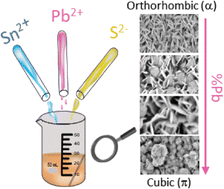Phase control in solution deposited tin monosulfide thin films: the role of Pb2+ cations†
Abstract
A “single pot” solution deposition methodology was employed to fabricate phase-controlled lead-doped tin monosulfide thin films. Different Pb2+:SnS2+ cation ratios were used for preparing SnS:Pb thin films on GaAs and FTO substrates. The compactness, phase purity, and growth rate of π-SnS were shown to improve by adding Pb2+ cations to the deposition solution. A thin PbS intermediate layer was spontaneously formed between the GaAs substrates and π-SnS thin films. High resolution X-ray diffraction showed that Pb is distributed as a solid solution in the π-SnS lattice. X-ray photoelectron spectroscopy indicated that the π-SnS film concentrations contain up to 3% of Pb, and that increasing the Pb content gives rise to increased Sn–S bonding strength and improved resistance to oxidation. The introduction of Pb to the solution used for deposition of SnS thin films (Pb-doping) slightly decreased the band gap and enhanced the electrical characteristics of the π-SnS films obtained, as demonstrated by Kelvin probe force microscopy and optical spectroscopy in the visible range. Moreover, deposition under conditions known to encourage formation of the orthorhombic α-SnS phase led to a gradual transition from the α-SnS phase to the π-SnS phase with increasing concentrations of Pb2+. These results demonstrate a straightforward method for achieving phase control in SnS thin films while enhancing their physical properties for optoelectronic applications such as thin film solar cells. The results were corroborated using density functional theory simulations of substitutional Pb defects in SnS phases, pointing out the concentration of Pb substitutionals required to stabilize π-SnS, which is in agreement with experimental results.



 Please wait while we load your content...
Please wait while we load your content...